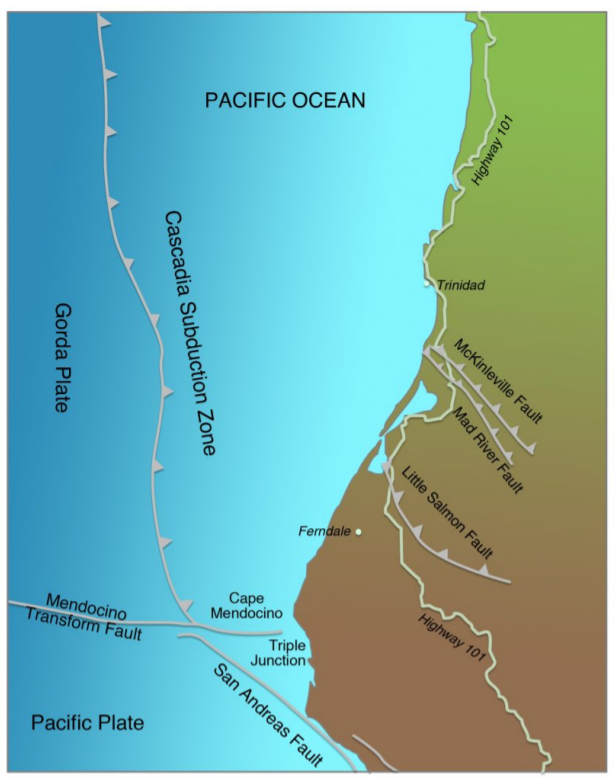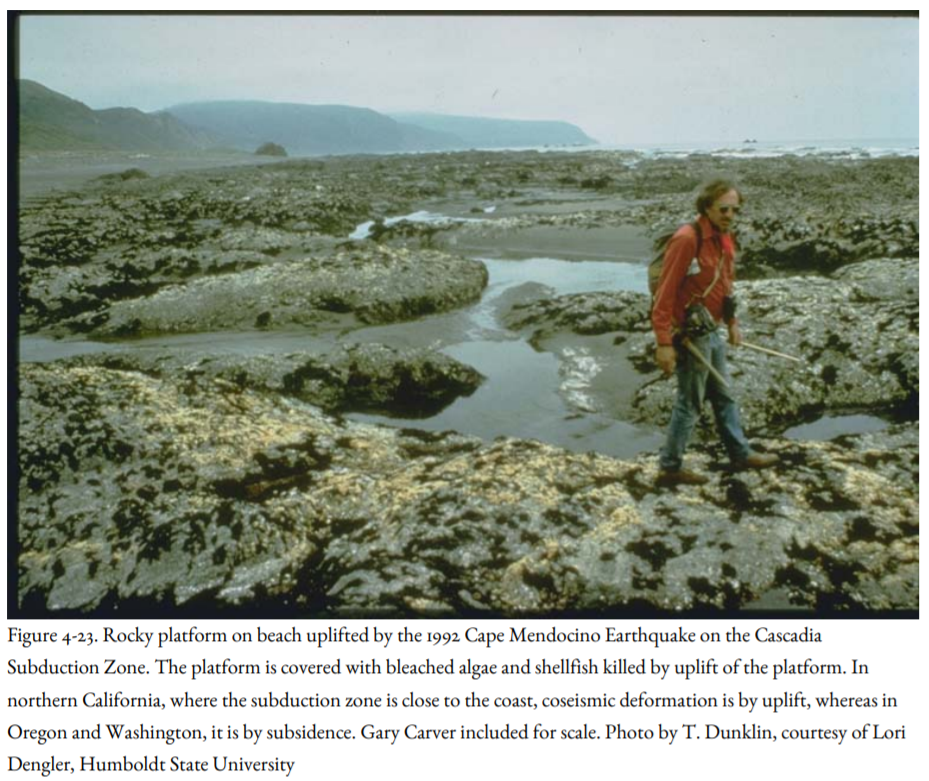5.4.8: Northern California; It’s Not the Same South of the Border
- Page ID
- 5949
Overview
The subduction zone in northern California is different from the rest of Cascadia. Off Oregon and Washington, it lies at the base of the continental slope but in northern California, it turns toward the southeast and angles up the continental slope, headed for the Triple Junction of the North American, Pacific, and Gorda plates beneath the village of Petrolia (Figures 2-4, 4-22).
The southern end of the subduction zone apparently ruptured during April 25, 1992, Cape Mendocino Earthquake of M 7.1, the only part of the subduction zone to have broken in an earthquake during the seismograph era. This earthquake caused $64 million in damage; 202 buildings were destroyed, and 356 people were injured, although nobody was killed. The damage was limited because the high-intensity zones of VII-IX were around small villages east of Cape Mendocino. The larger cities of Eureka and Arcata were farther away, and intensity was lower there.


The mainshock, a zone of shallow aftershocks, and GPS observations before and after the earthquake suggest that the earthquake produced ten to sixteen feet of slip-on an east-dipping fault plane with the mainshock at about six miles depth. There was no surface rupture onshore, although a fifteen-mile section of coastline was uplifted one to five feet, killing off a tide-pool community of barnacles, mussels, sea urchins, and coralline algae (Figure 4-23). Several kinds of evidence, including older marine terraces uplifted by prehistoric earthquakes and a comparison of the slip in 1992 with the long-term convergence rate between the Gorda and North American Plates, give a recurrence interval for 1992-type earthquakes of a few hundred years, perhaps as low as one hundred and fifty to two hundred years. However, the prehistoric Holocene terraces were uplifted in a longer section of beach than the 1992 uplift, suggesting that the older earthquakes were larger.

This recurrence interval is about half as long as the recurrence interval of Cascadia earthquakes in Oregon and Washington based on buried marshes, and the M 7.1 earthquake is small compared to the M 8 or M 9 earthquake that is awaited by the rest of Cascadia. Should this part of the subduction zone expect earthquakes in the M 7.0 to 7.5 range rather than the monster event Satake envisioned in A.D 1700? For insight, we return to southwest Japan, where part of the Nankai Subduction Zone comes ashore at the Izu Peninsula, just as the Cascadia Subduction Zone heads for the coast at Cape Mendocino. A long historical record in Japan shows that large earthquakes occur on the land part of the Nankai Subduction Zone at the Izu Peninsula at intervals of seventy to eighty years, whereas the more typical part of the subduction zone is struck by earthquakes of M 8 or larger every one hundred to one hundred and fifty years. Some of the Izu earthquakes are M 6.5 to M 7.1, and in addition, some of the large M 8 events rupture across the peninsula as well as along the subduction zone at the base of the continental slope. This could explain the short recurrence interval near Cape Mendocino as well as the absence of the three-hundred-year buried marsh at some sites in Humboldt Bay. Some of the Mendocino earthquakes would be local, like the 1992 event, and some would rupture the entire subduction zone, like the 1700 event. However, at the moment, this is just a guess.
The shorter recurrence interval for earthquakes uplifting the marine terraces near Cape Mendocino is confirmed by the recurrence interval based on turbidites in the Trinidad, Eel, and Mendocino submarine channels, which is 133, 75, and 34 years, respectively. Earthquakes strike there more frequently, and they are more variable in their return times. This may be due to earthquakes on the San Andreas Fault south of Cape Mendocino or to crustal earthquakes on active faults near the coast (Figure 4-22). Crustal faults are discussed further in Chapter 6.
The 1992 earthquake differed from the expected behavior of a subduction-zone earthquake farther north in another way: the shoreline was uplifted rather than downdropped. The explanation for this is seen in Figure 4-15. The subduction zone is much closer to the coastline in northern California than it is farther north, and thus it is in the area where uplift would be predicted, not subsidence. But what about the subsided marshes at Humboldt Bay (Figure 4-13)? These marsh burials are related to local crustal faults, not the subduction zone (discussed further in Chapter 6).


